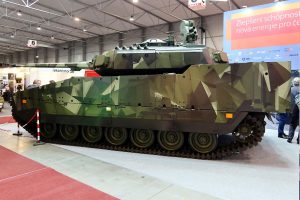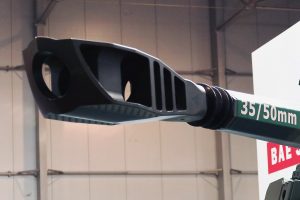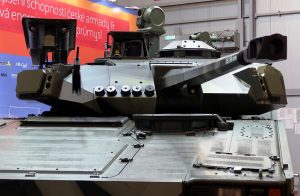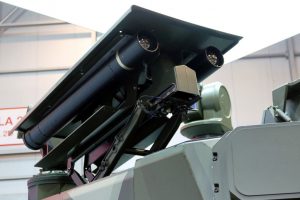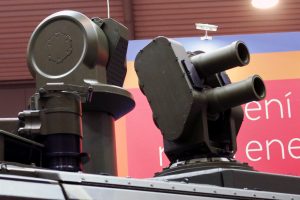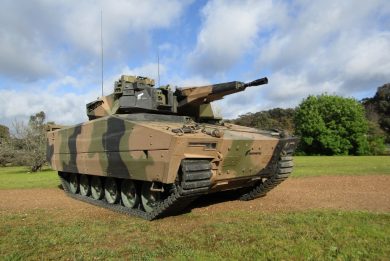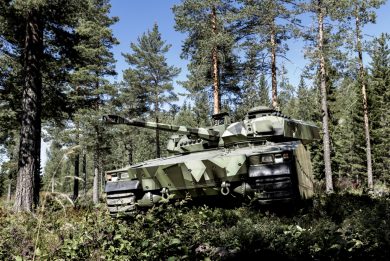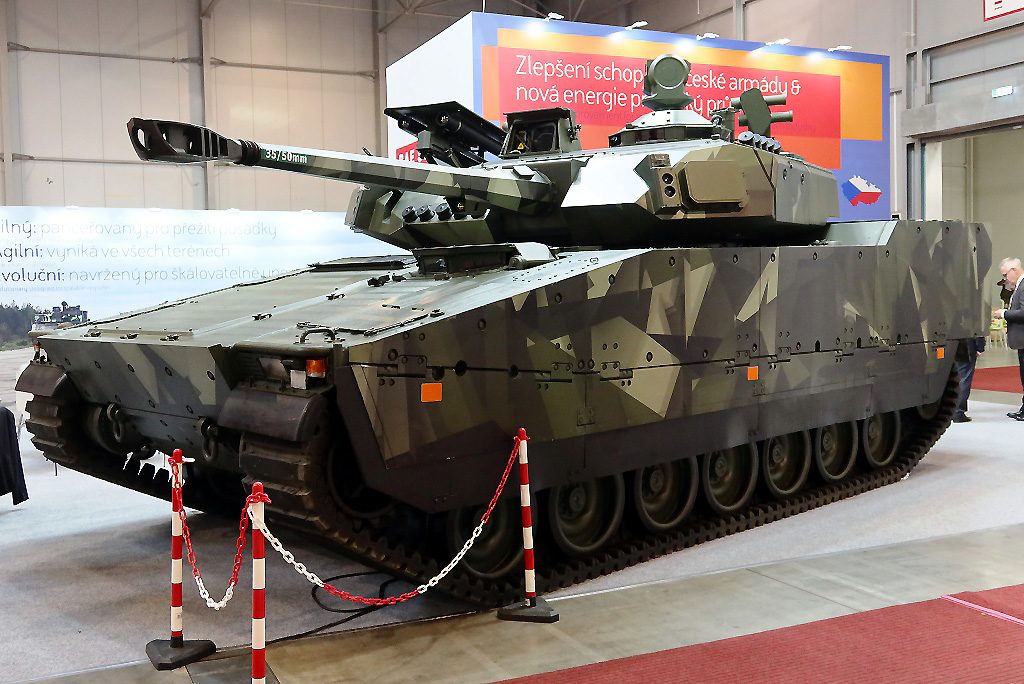
Future Forces 2022: awaiting the CV90 contract signature
Four years ago the three competing platforms aiming at becoming the future Czech Army infantry fighting vehicle were all present, either in real or model. Following the announcement last July that announced the selection of the BAE Systems Hägglunds vehicle, the CV90, this was obviously the only one present in real, at this year edition of the Prague exhibition.
That said, the vehicle visible in Hall 2 might well not represent the final configuration that will equip the heavy forces of the Czech Army: a discussion is still ongoing about the cannon, with pros and cons nearly equally divided between the 30 and the 35 mm calibre.
Commonality and local production of ammunition are the main pros for the smaller calibre. In fact the Mk44 Bushmaster II chain gun is already in service in the Czech Army as it arms Rafael’s RCWS 30 turrets that are fitted to the infantry fighting vehicle (IFV) version of the Pandur II. Seventy-two such vehicles are in service and fire the 30×173 mm rounds, while tracked IFVs currently in line with mechanised infantry battalions, BVP-1s and BVP2s of Soviet origin, fire the 30×163 mm ammunition, which is produced in the Czech Republic by STV and Excalibur. As the CV90s would replace BVPs in Czech Army service, arming them with the Bushmaster II would mean having a single medium calibre ammunition.
Looking however at the terminal effect the 35×228 mm round is universally recognised as having much higher performances compared to the smaller calibre. This is true in all types of rounds, from the kinetic energy APFSDS, to standard multipurpose HE rounds, and even more when considering Air Burst rounds, the load in terms of number and size of pellets being exponentially higher.
The choice of having two different calibres has been done by the neighbouring Slovak Republic; talks are ongoing between the once united nations, and should the local ammunition production be an issue, each one of the nations might set up a production line, one for the 35 and the other for the 30 mm, allowing mass production savings.
Having the same vehicle in service, with the same weapon, might also bring to further cooperation, and savings, in the field of simulation, training etc, not to mention the fact that should the two armies be called to operate together, which is not a remote probability, having units with similar firepower would definitely allow better integration.
Talking industry, BAE Systems Hägglunds is ready to provide both solutions. A few weeks ago the Netherlands received the first CV90 Mk IV, which was rolled out from the Örnsköldsvik assembly line, the latest iteration of the CV90 being fitted with an all-digital turret, once known as “D-Turret”, that was developed following the requirements of the Czech Army when this issued a request for a new IFV in 2015. Among key requirements at that time we could find that concerning the 30 mm Mk 44 cannon, with the aim of maintaining commonality with the Pandur IFV. The process was then interrupted and was revived two years ago, and the Swedish vehicle branch of BAE Systems proposed the vehicle with the two calibres. The fact that the platform has been selected but the armament is still in discussion means that there is a discussion ongoing, quite probably between logisticians and operational operators.
When the Netherlands decided to increase their fleet of CV90s, they went for the all digital version, but for them the 35 mm cannon was a must, firstly to maintain commonality with existing vehicles, and secondly considering lethality.
We will see what will be the choice of the Prague Ministry of Defence in a few months.
Another key factor in the closure of the contract is industrial cooperation, this having replaced the old offset concept, which could be split between direct and indirect. Now nations want to exploit an opportunity like the acquisition of a major weapon system to improve the know-how of their defence industry, indirect offsets being mostly a matter of the past.
BAE Systems Hägglunds has already identified a number os strategic partners within the Czech defence industry, although no names are made, a non-disclosure agreement with the customer preventing the company to provide any detail also on the proposed configuration.
Beside the cannon issue, the main similarities between the Czech CV90 Mk IV configuration and that of the two other countries that selected this vehicle will be very significant, 95-98 % according to company sources, and differences will be mainly in the C4I area that is country specific, with black boxes located i different places. Some other options such as the coaxial machine gun that is located in a pod hosting 1,000 7.62×51 mm rounds and with the capability to reach a 60° elevation for urban missions, the option of a more classical layout with the fixed MG and the ability to reload it under armour being also offered. Some adaptations to the turret basket might also be required, while an extra weapon should be installed on the vehicle, as well as probably some UAVs. The company is offering Soucy rubber tracks as standard, however steel tracks are also available, a decision for a training and a combat track being also among possibilities. Optronic will be similar to the one chosen by Slovakia.
It is clear that systems provided by what the company defines as System suppliers, such as the gun, the engine, and so on, will mainly not become the subject of local production, while their maintenance might well be carried out by the Czech industry. Two strategic partners have been identified for the chassis, the turret, and the integration, no decision having yet been taken if one of them will take all or if the work will be split. Although as said no names were made, EDR On-Line retains that these should be picked up between two state companies, VTU (Vojenský Technický Ústav, Military Technical Institute) established by the Ministry of Defense in September 2012, and VOP CZ (Vojenský Opravárenský Podnik, Military Repair Company), and come private, Excalibur Army, the latter involved in the Pandur II programme among others. A company that will certainly be involved is Meopta, which will be responsible for the gunner’s sight. VR Group will be involved in the simulation package, as it has already provided such systems for the BVP 2 and other vehicles.
A number of subsystems provided by Build-to-Print suppliers ranging from mechanical to electronic and electric components will potentially be part of the industrial cooperation agreement. Of the list of around 100 companies established in 2015 when the first bid was launched, EDR On-Line understood that some 40 were retained at the current stage in the new acquisition process. Discussions on the Transfer of Technologies, production and support are still ongoing, the Integrated Logistic Support package, as well as the training one being also part of the deal.
BAE Systems Hägglunds has a long record of industrial cooperation with various customers, assembly having also been carried out at Örnsköldsvik in Sweden with the subcomponents coming from the customers’ nations, “and we always managed to deliver on or ahead of time,” a company sources told us.
The announcement made on July 20th this year stated that the Czech Army will receive 210 CV90 Mk IV; this decision was taken after thorough trials that lasted six weeks, however no details were provided n the outcome of those tests, as Slovakia did a few months earlier. Of these 164 will be fitted with the digital turret, and will come in three different configurations, IFV, Command and Control, and Reconnaissance. The latter will be fitted with a telescopic mast at the rear, which will carry an optronic system as well as a radar, a layout similar to the one adopted by Norway. The unturreted versions will be the Forward Observation, Engineer, Ambulance, and Repair and Recovery variants. Beside the inevitable differences from the same variants adopted by previous customer nations, the company underlines that all those variants have already been designed and produced, and therefore it is able to offer a full catalogue of designs and options that considerably ease the definition of the desired configurations by new customers. And this, according to BAE Systems Hägglunds, is the huge advantage of having a wide customer base, which along the time brought to the development of many different solutions, and which is also providing a continuous flow of lessons learned, both from training as well as from operations. In mid-November 2022 BAE Systems Hägglunds increased the number of variants in service from 15 to 17 by adding two new role variants to the Swedish fleet in the ongoing renovation programme that is ongoing there. Based on a Swedish Army requirement, these are the Forward Maintenance vehicle, which will provide critical frontline support, repair, and recovery for other vehicles, and the Combat Engineer variant, which will significantly grow the ability to ensure route clearance and deny enemy forces mission critical mobility.
Photos by P. Valpolini

